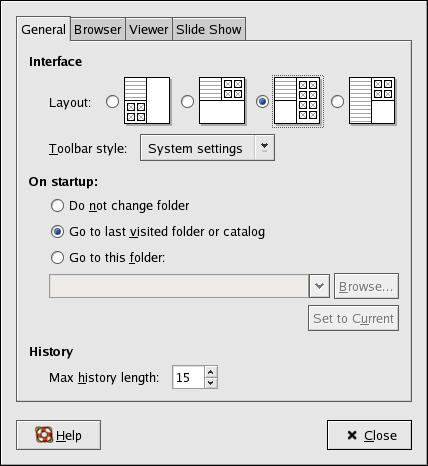Chapter 11. Working with Images
Digital images have grown in popularity with the development of the graphical Internet and the increasing quality of digital cameras. There are several types of image files, some of which are created using sophisticated illustration software packages, while others are made from digital sources such as a scanner or camera. You may have downloaded some of these image files from the Web or received them in an email. You may also want to create your own images to send to others. You can view and modify the most common types of image files using the many applications included in Red Hat Linux.
11.1. Viewing Images
This section discusses some of the common tools for viewing image files. Certain tools included in Red Hat Linux are specialized applications with several functions that enhance your image viewing experience; while others are general-purpose file managers that have integrated image viewing functionality.
11.1.1. Using Nautilus to View Images
Nautilus is a general-purpose file manager and browser for your graphical desktop environment. Nautilus has many functions beyond simple image viewing; however, for this section, we will use it for basic image browsing. For more information about Nautilus, see Chapter 2 Using the Graphical Desktop.
Nautilus is known for its ease-of-use
and it handles images with the same ease as it does for other file
types. To begin browsing your image collection with
Nautilus, double-click your home desktop
icon:

You will be presented with a view of all files and folders within your home directory. Double-click the image (or the folder containing the image) and Nautilus will open the file or folder within its browser window. Figure 11-1 shows that Nautilus automatically creates thumbnails of any images in your folders:
Double-click on any thumbnail icon to view the image in its native size. The image will load within the browser window. To increase or decrease the size of the viewed image in Nautilus, click on the zoom buttons next to the Location: field as shown in Figure 11-2:
Click the + button to increase the size of the image or - to decrease it.
11.1.2. Using gThumb
gThumb is a powerful image viewer for graphical desktop users that supports several image file formats, including:
JPG/JPEG
GIF
PGM
XPM
PNG
PCX
TIF/TIFF
PPM
BMP
gThumb is useful for viewing individual image files as well as browsing collections of files in folders. It supports zoom in and zoom out functions, as well as thumbnail sized preview icons of all image files within a directory. It also supports several advanced options not found in Nautilus.
gThumb can be started from your desktop panel. Choose Main Menu => Graphics => gThumb Image Viewer or type gthumb at a shell prompt to start the application. gThumb will browse your user home directory by default. If you have any images in this directory, the gallery panel will automatically generate thumbnails for you to highlight and view in the main display area.
The interface of gThumb is straightforward. Double-click an image preview thumbnail to view it within the main gallery area. The image can be zoomed in and out, set to full screen (which covers your entire screen with the image), and be printed on your configured printer. The toolbar allows you to fit the image to the display window, collect multiple files into a catalog for easier access if they are located in different directories, and write descriptions about the images.
The gThumb interface also has a text field for you to enter a particular path to your image directories. Right-clicking on an image in the display area opens a pop-up menu of file management options such as renaming, moving, copying, and converting an image from one file format to another. You can also set an image as your desktop wallpaper within the pop-up menu.
You can combine functions within gThumb
and create a dynamic presentation effect for groups of images within a
directory. In the text field below the toolbar, type the path to the
the directory where your images are located and highlight the first
image in the main gallery panel. Click the Slide
Show button on the toolbar and you will start a
full-screen slide show where gThumb displays
images in full screen. By default, each image in the slide show is
presented for 4 seconds. You can stop the slide show at any time by
pressing
11.1.2.1. Changing your Desktop Wallpaper with gThumb
To change your desktop wallpaper with gThumb, right-click on an image, choose Set Image as Wallpaper, and then choose the orientation of the image. You can center the image on the page, which sets the image at its native resolution on the desktop and fills the rest of the space with the default desktop color if the image is smaller than your desktop resolution. You can also tile the image, which fills your desktop with multiple instances of the image. You can also scale and stretch the image, which resizes the image from its native resolution to fit your screen size. To restore your desktop wallpaper to its default, right-click anywhere in the main gallery area and choose Set Image as Wallpaper => Restore.
11.1.2.2. Configuring gThumb
gThumb allows you to customize several settings by choosing Edit => Preferences.
The preferences pop-up menu lets advanced users change several of the default gThumb behaviors. You can choose the layout of the application window, customize a default image directory on startup, change thumbnail preview sizes, and change the interval between cycled images during a slide show.
To find out more about using and configuring gThumb, choose Help => Contents from the main menu.



